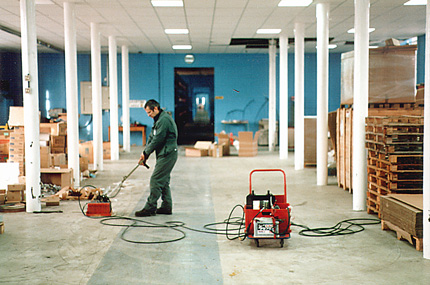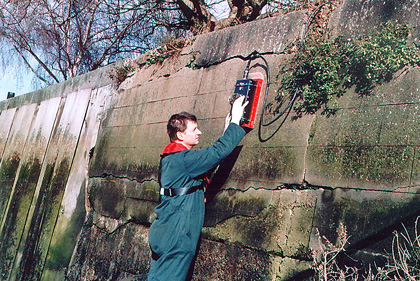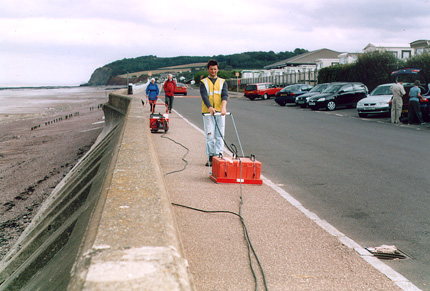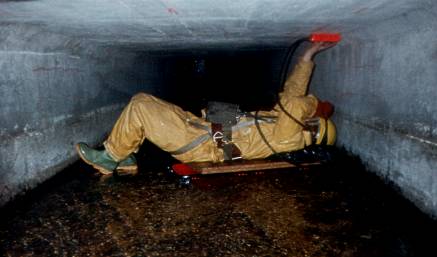
Investigating floor construction using ground penetrating radar


Investigating floor construction using ground penetrating radar
Ground penetrating radar (GPR) or ground probing radar is a useful method for NDT testing of buildings, bridges, tunnels and retaining walls, and for general concrete testing applications. The ground penetrating radar method is non-destructive and non-invasive, revealing a wealth of internal detail without the need for coring or breaking out. Survey results are presented as easy to understand engineering CAD plans, elevations and sections.
Ground penetrating radar equipment can be adapted for different requirements using interchangeable antenna units. Low frequency GPR antennas locate large steel elements in concrete and detect deep-seated voids. Small, hand-held, high frequency antennas are best for locating rebars, cable ducts and tie bars. The high frequency devices can also assess the integrity of reinforced concrete and brickwork, and find small voids, delaminations and other defects.
Ground penetrating radar is an effective concrete testing method for investigating factory floors. GPR surveys can measure the thickness of reinforced concrete slabs and determine the depth and spacing of rebars. Information can generally be obtained through more than one layer of reinforcing mesh. Individual structural elements such as beams and girders can be identified, together with voids, delaminations and other defects not easily found by coring alone. Ground penetrating radar can be especially useful on older, multiple use floors which have been repaired and partially replaced over time. The patchwork of different floor thicknesses and variable reinforcing mesh distribution often presents significant complications to structural engineers. A GPR survey can characterise floor construction, providing vital assistance for planning the installation of new plant.

Ground radar profile of beams below a double mesh reinforced concrete floor

Searching for defects undermining a river bank retaining wall
Ground penetrating radar surveys can be customised to investigate concrete or masonry retaining walls, to produce profiles of the wall thickness. Voids and other defects can be identified both within the wall and behind the internal boundary of the structure.
Vertical profiles are carried out by lowering the antenna down the external face of the retaining wall. Horizontal profiles are useful for identifying lateral changes in thickness, particularly if a buttress type construction is suspected, and for defining the extent of a large defect. The interpreted data is used to construct elevations and sections of the wall's internal construction.

Locating voids behind sea defences along a promenade wall
Sea wall GPR investigations can assist engineers for breach detection and structural assessment. Breach detection involves surveying the ground immediately behind the sea wall, to look for voids and loose ground caused by marine incursions into the wall. For structural assessment applications, GPR surveys can produce typical wall sections for structures where records no longer exist.
Generally ground radar surveys are best commissioned prior to the commencement of major renovation programmes. The results can be used for targeting costly remedial operations and the early identification of potential failure zones.

Profiling the soffit inside a concrete box culvert
Ground radar surveys are used on bridge structures for assisting load assessments and as a follow-up to routine inspections. A GPR survey is able to locate internal defects for the accurate targeting of intrusive investigations.
On masonry arch structures, GPR is used to check barrel thickness, locate defects and identify backing on the haunches of the arch. Ground penetrating radar investigations of reinforced concrete structures check slab and element thickness, measure rebar spacing and can assess the condition of internal steelwork.
Investigates thickness and internal structure of floors and walls
Locates internal steelwork in concrete such as rebars, girders & cable ducts
Identifies backing behind masonry arches
Locates voids, cracks and delaminations in concrete and masonry
Finds zones of water penetration and corrosion within defective concrete
Determines thickness of brickwork and masonry construction layers
Phone us at: +44-1905-619531 or e-mail us at: [email protected]